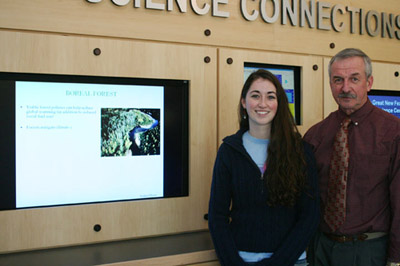|
Science
isn't all
lab coats
and beakers.
Students
taking science
classes
tackle subjects
such as
weather
patterns,
animal behavior,
and natural
habitats.
Roll those
subjects
into one
and you've
got some
of the hottest
science
subjects
in the news
today, global
warming
and environmental
management.
After months
of walking
past the
plasma screens
in the Science
Center ,
Geography
Professor
Al Rydant
began thinking
that these
subjects
would make
an interesting
addition
to the campus
announcements
and weather
station
read-outs
that were
displayed
there. Instructional
Technology
Liaison
Wendy Petschik
liked his
idea and
reserved
one of the
screens
for the
presentations.
“It's just
something
nice,” Rydant
said. “To
use the
display
for the
things we
do.”

He found
inspiration
in a calendar
that spotlights
the endangered
places and
animals
of British
Columbia
, and enlisted
the help
of junior
Casey Moran
to create
some informative
PowerPoint
presentations.
Moran is
a junior
with a double
major in
Geography
and Elementary
Education,
so she is
getting
a little
practice
in what
it takes
to create
something
a student
might, hopefully,
learn from
and find
interesting.
PowerPoint
is a staple
program
in classrooms
and office
environments,
and was
one of the
more popular
workshops
offered
by Instructional
Technology
during the
winter break.
Moran knew
the basics
of PowerPoint
when she
started
the project,
but found
that the
basics weren't
always enough
to keep
the four-slide
presentations
interesting.
Instead
of relying
on plain
color backgrounds
she figured
out how
to use photos
as backgrounds.
The photos
helped make
the background
interesting,
but then
she had
to worry
about if
the text
would be
clear enough
to read.
Once she
knew the
text was
visible,
she experimented
with different
ways to
present
it. PowerPoint
gives users
a variety
of animations;
from a fade-in
to bouncing
the text
around the
screen before
placing
it.
PowerPoint
allows the
user choose
how to advance
from slide
to slide
as well.
Slides or
animations
can be advanced
with a mouse
click, but
this is
only good
if someone
is available
to control
the presentation.
Moran needed
the points
and slides
to come
up automatically,
and the
presentation
to loop
continuously.
Custom animation
tools allowed
her to time
the appearance
of text
and photos
on individual
slides,
and determine
how long
each slide
should stay
on the screen
so people
wouldn't
have to
speed read
from one
slide to
the next.
It took
a little
bit of poking
around the
program,
but Moran
gained some
valuable
experience
that she
can take
to the classroom
with her
when she
begins student
teaching.
“You could
use (PowerPoint)
with any
grade level
too,” she
said.
The presentations
are a simple
use of common
software
that will
give passers-by
information,
and hopefully
act as a
call for
resource
protection
and habitat
stewardship,
according
to Rydant.
Moran is
creating
approximately
10 presentations
based on
the habitats,
flora and
fauna featured
in the calendar,
and will
probably
create one
presentation
based on
a service
learning
trip to
Ecuador
that she
and Rydant
will participate
in over
spring break.
The plasma
screens
are located
at the end
of the ground
floor foyer
area, near
the building
doors that
open toward
the Student
Center
Contact
Academic Technology
to find
out what
possibilities
are available
to you.
Academic
Technology
Jenny Darrow – jdarrow@keene.edu or
358-2340
Linda Farina – lfarina@keene.edu or
358-2381
Judy Brophy - jbrophy@keene.edu or 358-2384
|